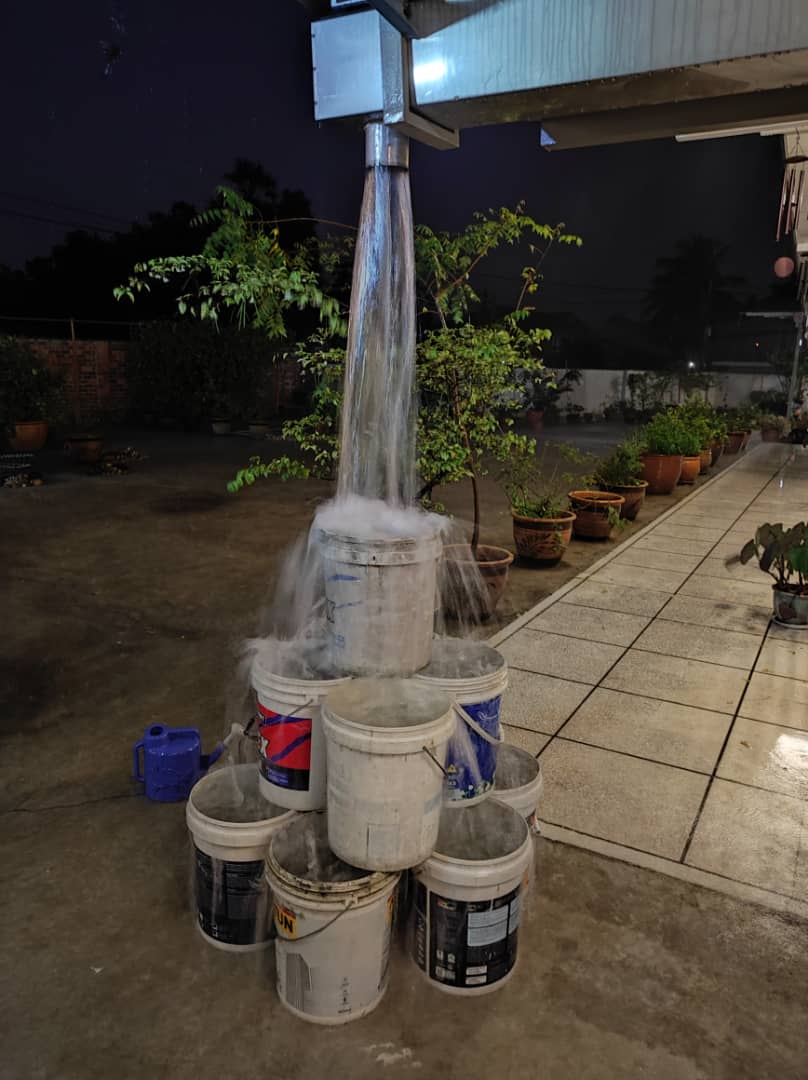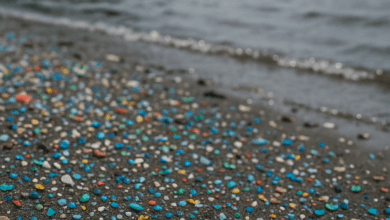

Just as we keep umbrellas on hand for a rainy day, shouldn’t we be keeping water in store for a dry day? How much of the voluminous rain that fell in December was channelled into tanks for use in July? The practice of harvesting rainwater has yet to spread in Malaysia, but one Ipohite is well into the habit.
Eco warrior Ignatius Chew builds rain fountains every wet day by stacking pails to form layers beneath the roof gutters of his house in Chateau Garden. He has nine collection points where rainwater is channelled to fill the top pail and then cascade down to several pails in the bottom layers. Within seconds, all the pails are overrun with water.
Ignatius has 20 normal pails and 30 old paint pails in which the rainwater is stored for use to fill the toilet cisterns, for general house cleaning, to wash the car, and water the garden plants. All the water stored in pails is used up within days before mosquitoes can breed in them. Ignatius also collects water condensation from the air conditioners, and a 1HP aircon that runs for eight hours can fill a small pail.


He also keeps nine 450-gallon black tanks covered with mosquito netting for long-term storage and emergency use, if taps run dry as may happen. His DIY (do it yourself) rainwater harvesting system enables tap water to be restricted for use mainly in cooking and bathing.
Says Ignatius: “Creating the rain fountains isn’t just a matter of saving money on tap water usage; it is to save the environment by appreciating natural resources and using them wisely for our needs.”
Ignatius fully supports the concept of rainwater harvesting in big and small ways by individuals and corporations, as well as by local and state governments. Why let the rain go to waste or let it cause flooding?
If you’re keen to copy Ignatius’ rain fountain, the opportunity is coming with the April showers just two months away. Get some pails and stack them in three concentric circles of 6-4-1 pails like a narrowing pyramid near a rooftop gutter downpipe. As your downpipe reaches the drain, cut it at a height well above the top pail. Fix an elbow that you can buy in a hardware shop to direct the rainwater into the top pail.
If you do not wish to modify the existing gutters, you can fix an additional rooftop gutter for this purpose. A mundane way is simply to buy a rain barrel and connect it to a downpipe that channels rainwater from the gutter into the barrel.
If you live in a condominium, persuade the management to install a rainwater harvesting system with a large storage tank on the ground. The installation cost per household in a 500-unit condominium will be less than RM60. As condominiums use copious amounts of water daily for landscaping and cleaning services, the savings in water usage are simply enormous.
The World Health Organisation recommends that each person should use only up to 165 litres of tap water a day. But in Malaysia the usage is 219 litres per capita per day. In Singapore it is only 141 litres. Low tariffs and extensive pipe leakages (35% of tap water is leaked out) are the main reasons for huge wastage in Malaysia. There is also the bizarre case of one state giving away free tap water.
With memories of the December Deluge still fresh in our minds, do we need to ponder the need to save water? Yes. In October 2000, the Financial Times of Britain reported: “Supplies of fresh water will probably be the biggest environmental problem of this century.” That was written 22 years ago, at the start of our new century. Already climate change was visibly hurting us then.
The New York Times published a warning in 2018 that climate change was producing more severe weather disruptions known as El Ninos and La Ninas. El Nino brings deluge, while La Nina brings drought. As these twins are on a lightning world tour, one after the other, you can expect La Nina to turn up in July. The land will soon become parched in many states.
The south Indian city of Chennai experienced a deluge in 2015 and a drought in 2019, four years later. That was slow, slow. Now it’s quick, quick. Capetown in South Africa suffered a three-year drought that made city officials ponder towing an iceberg from Antarctica to provide drinking water. Fortunately, the rains came in 2018.
We continue to splash water as if all memory of droughts has been erased. Yet it was not so long ago that several states experienced water crises. Experts worry that one day Malaysia will have to impose water sanctions, rationing tap supply to ensure that everyone has just enough to get by. One clear sign is the number of searingly hot days in a stretch, and we may break out into a sweat come July.
However, in 2019, despite heavy downpours, Simpang Renggam in Johor saw water rationing affecting 150,000 people because not enough rain fell in the dams. Even on stormy days, the rain may fall in the wrong places and cause flooding instead.
The easiest way to ensure plentiful water supply in dry months is to store rainwater during the wet months. Malaysia has 973 billion cubic metres (bcm) of annual rainfall, equivalent to 390 million Olympic-size swimming pools. Roughly half this amount (496 bcm) runs off the surface with 70% of it as flood discharge.
In 2016, President of the Institution of Engineers Malaysia Datuk Lim Chow Hock suggested that the definition of a water catchment area be extended beyond the upper stream forested areas to include the whole landmass right up to the sea. It was a breakthrough idea that nobody appreciated.
Let’s face the political reality for now: we can’t protect every virgin forest tree from logging and we can’t enlarge the buffer zones to protect catchment areas. Politicians have other considerations besides the environment. But you can persuade the state and city authorities to enact legislation for rainwater and stormwater harvesting.
Homeowners and building managers should be incentivised to install rainwater harvesting systems through the granting of property assessment tax rebates. Citizens should also press for the construction of swimming-pool size tanks beneath school fields to store rainwater channelled through a network of pipes and gutters that collect surface runoff. The stored water can then be pumped to treatment plants.
The time to build a massive network of rainwater harvesting systems is now, before the next December deluge. Never wait till it’s too late.
Disclaimer: The views and opinions expressed in this article are those of the author and do not necessarily reflect the official policy or position of Ipoh Echo.


